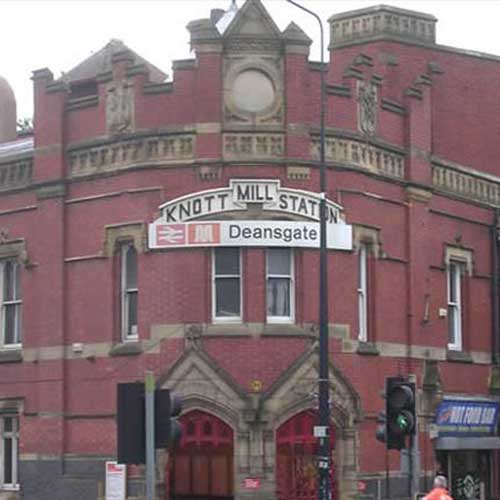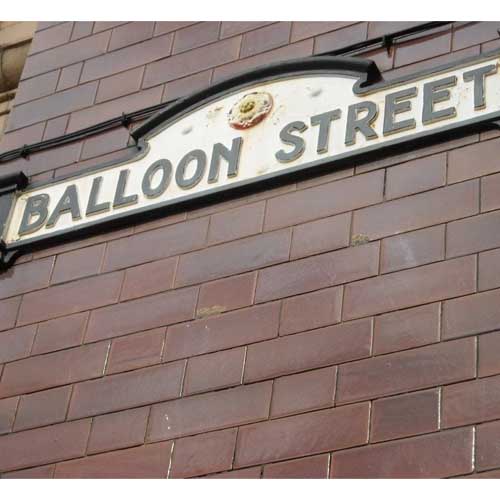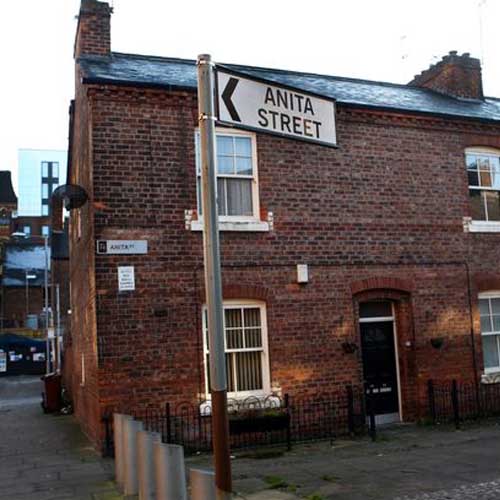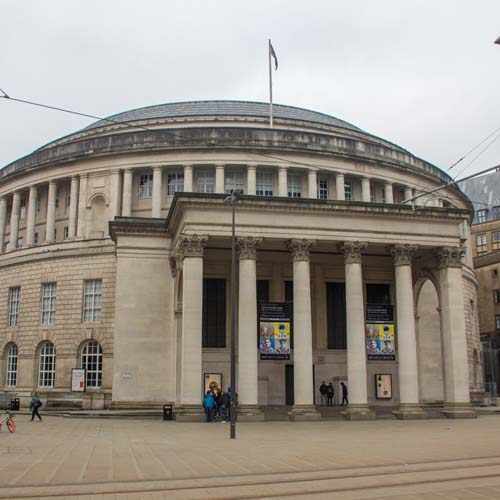Street names are interesting because they often have historical or cultural significance that reflects the city or region’s past, and the street names of Manchester are no exception. Manchester’s street names offer insight into the social and economic trends that have shaped the area over time, how the people who lived in Manchester used to live, the industries and businesses that thrived here, and the events that have occurred.
Many of us just stroll down the streets of Manchester not giving a second thought to the names and history of them. Here you can see a variety of street names, their origins and the fascinating history behind them!
Deansgate

Deansgate gets its name from the fact that it was once the boundary line of the lands of the Dean of Manchester. The term “gate” is derived from the Old Norse word “gata,” which means street. So, Deansgate literally means “the street of the Dean,” reflecting its historical association with the ecclesiastical authorities of Manchester. Over time, Deansgate became an important commercial and residential street, with many of the city’s wealthiest merchants and residents living and working in the area. Today, it remains one of the most iconic and historic streets in Manchester.
The history of Deansgate dates back to the Roman era, when the street formed part of the Roman road network in the area. In the centuries that followed, Deansgate became an important commercial and residential street, with many of the city’s wealthiest merchants and residents living and working in the area.
Today, Deansgate is one of the most vibrant and dynamic areas in Manchester. The street is home to a wide range of shops, from high-end boutiques to independent bookstores and vintage clothing shops. There are also a number of popular bars and restaurants, offering everything from traditional pub food to contemporary cuisine.
One of the most notable buildings on Deansgate is the Beetham Tower, which was the tallest building in Manchester when it was built in 2006. The tower is home to a number of luxury apartments, as well as The Hilton Hotel, a restaurant, and a cocktail bar, Cloud 23. However, Deansgate Square South apartments, built in 2018, stand over four metres high and now surpasses Beetham Tower in height.
Deansgate is also home to a number of cultural institutions, including the John Rylands Library, one of the most beautiful libraries in the world. The library is home to a wide range of rare books and manuscripts, as well as a collection of stunning historic manuscripts.
Another important cultural institution near Deansgate is the Manchester Opera House, which is one of the city’s most important venues for live theatre and music performances. The theatre has hosted a wide range of productions over the years, from classic plays to contemporary musicals.
Deansgate is also home to a number of important historic buildings, including the Old Granada Studios, which was the home of Granada Television for many years. The building is now being redeveloped into a mixed-use space, with plans for a hotel, apartments, shops, and restaurants.
Overall, Deansgate is one of the most vibrant and dynamic areas in Manchester, with a rich history and a wide range of cultural, culinary, and commercial attractions. Whether you’re interested in shopping, dining, or exploring the city’s rich cultural heritage, Deansgate is definitely worth a visit.
Balloon Street


Balloon Street is named after the historic hot air balloon factory that was once located in the area. In the early 19th century, Manchester was a hub of ballooning activity, with numerous inventors and entrepreneurs working to develop new types of balloons and flying machines. One of these pioneers was James Sadler, who built his first hot air balloon in Manchester in 1784. Sadler went on to establish a balloon factory on Balloon Street, which became an important centre of ballooning research and development. Today, the street is named in honour of this important chapter in Manchester’s history.
Balloon Street is a historic and important thoroughfare located in the heart of Manchester’s bustling Northern Quarter. The street is named after the hot air balloon factory that was once located in the area, and is now a hub for commercial and cultural activity in the city.
Today, Balloon Street is home to a variety of important commercial and cultural landmarks. One of the most prominent is the Manchester Arena, a world-famous concert venue that hosts some of the biggest acts in music and entertainment. The arena has a seating capacity of over 21,000 people, making it one of the largest indoor venues in Europe.
In addition to the Manchester Arena, Balloon Street is also home to several important office buildings and corporate headquarters. One of the most prominent is the One Angel Square building, which is the headquarters of the Co-operative Group. The building was designed to be one of the most environmentally friendly buildings in the world, and features a range of innovative features, including a rainwater harvesting system and an on-site power generation facility.
Balloon Street is also known for its vibrant street art scene, with a number of colourful murals and installations located throughout the area. One of the most famous is the “Northern Quarter Angel,” a striking mural of an angel that adorns the side of a building on the corner of Balloon Street and Tib Street. The mural was created by the street artist Akse, and has become an iconic symbol of the Northern Quarter.
Overall, Balloon Street is an important and dynamic part of Manchester’s urban landscape. Its mix of history, culture, and modern amenities make it a must-visit destination for anyone visiting the city. Whether you’re looking for a night out at the Manchester Arena, a stroll through the Northern Quarter’s vibrant streets, or a glimpse of Manchester’s rich industrial history, Balloon Street has something for everyone.
John Dalton Street


John Dalton Street in Manchester is named after John Dalton, a famous chemist and physicist who lived in the city in the late 18th and early 19th centuries. Dalton is best known for his work on atomic theory and his discovery of the laws of partial pressures of gases. He was also a teacher and mentor to many young scientists, and he played an important role in the scientific community in Manchester and beyond. The street was named in honour of his contributions to science and his connection to the city.
Today, John Dalton Street is home to a variety of important commercial and cultural landmarks, including some of the city’s most important financial institutions. The street is a hub for business and commerce in Manchester, with numerous office buildings and corporate headquarters located along its length.
In addition to its cultural and commercial offerings, John Dalton Street is also an important transportation hub in Manchester. The street is served by several bus routes and is within walking distance of Manchester Piccadilly Station, one of the city’s major rail hubs. This makes John Dalton Street an ideal location for both visitors and residents of Manchester, offering easy access to all of the city’s many attractions.
Overall, John Dalton Street is one of the most important and vibrant streets in Manchester. Its combination of commercial and cultural landmarks, as well as its convenient transportation links, make it a must-visit destination for anyone visiting the city. Whether you’re looking for a day of shopping and dining, an evening of entertainment, or simply a stroll through one of Manchester’s most historic and beautiful neighbourhoods, John Dalton Street is the place to be.
Anita Street


Anita Street is a small residential street located in the Ancoats neighbourhood of Manchester, UK. While it may seem like an unremarkable street to many, Anita Street has a unique history that tells the story of the changing social and cultural landscape of the city. Prior to its current name, Anita Street was known as Sanitary Street, a name that reflected its original purpose as a site for public health initiatives in the 19th century.
During the mid-19th century, Manchester was facing a public health crisis. The city’s rapid industrialisation and urbanisation had led to overcrowding, poor sanitation, and widespread disease. In response, the city’s leaders initiated a series of public health campaigns aimed at improving living conditions and reducing the spread of disease. One of these initiatives was the creation of a network of streets designed specifically for the purpose of improving public health.
Sanitary Street was one of the streets created as part of this initiative. The street was designed with wider sidewalks, better drainage, and other features that were intended to reduce the spread of disease. The name “Sanitary Street” reflected the street’s original purpose, and it remained in use until the early 20th century.
Over time, however, the meaning of the name began to change. As Manchester’s population grew and the city’s industrial economy shifted, the area around Sanitary Street became home to a diverse mix of residents. By the mid-20th century, the street had become a working-class neighbourhood, and the name “Sanitary Street” began to take on a negative connotation.
In the 1960s, the city council decided to change the name of the street to Anita Street, in honour of a local resident who had been active in community organising and advocacy. The name change was part of a broader effort to rebrand the neighbourhood and improve its reputation. The new name reflected a new vision for the area, one that emphasised community, activism, and social justice.
Today, Anita Street remains an important part of the Ancoats neighbourhood, serving as a reminder of the city’s history and the ongoing struggle for social justice. The street’s original name, Sanitary Street, is a testament to the city’s early efforts to improve public health and reduce the spread of disease, while the name Anita Street reflects the neighbourhood’s more recent history and the ongoing efforts of local residents to build a strong and vibrant community. Together, these two names tell the story of a city that has faced many challenges over the years, but has remained resilient and committed to the well-being of its residents.
Minshull Street


Minshull Street derives its name from the Mynshull family, who were a wealthy family that owned two estates, Chorlton Hall and Hough End Hall. In 1755, Thomas Mynshull, a successful apothecary, passed away, leaving his fortune to his widow, Barbara.
She managed to maintain her wealth until she met a tall man named Roger Aytoun at Kersal races in Salford in 1769. Roger, who was over six feet tall and known for his love of fighting, was so intoxicated at their wedding that he required assistance to stand. However, when Barbara passed away, she left her fortune to Roger, who used the money to establish The 72nd Regiment of Foot or Manchester Volunteers, a regiment he funded by offering watches or pieces of his own clothing as incentives to join. Aytoun Street and the now-defunct Spanking Roger pub were both named in his honour. He was known as Spanking Roager because of his love of fighting.
Conclusion
These are just a few examples of the many road names in Manchester and their origins. As we can see, Manchester’s street names reflect its history, culture, and values, and can be used to honour important figures or events. In some cases, street names can become symbols of resistance or activism, serving as a reminder of past struggles and ongoing movements for social justice.
So tell us which is your favourite road name in Manchester and why?


